How fraudsters use Zelle and how to protect yourself
Zelle is a great way to transfer money electronically. It’s fast and easy. Unfortunately, those same qualities make it a popular target for scammers. Here’s what you should know about Zelle scams and how to protect yourself.
Zelle Basics
Zelle is a money-transferring service just like Venmo and PayPal. The main difference is that Zelle is housed in the websites and apps of credit unions and banks. To use Zelle, you can log into your Fortera online banking or mobile banking app and then transfer/receive the money. To use Venmo or PayPal, you must log into those apps.
Two Scams
The most popular Zelle scam starts with what appears to be a message or phone call from your bank. The bank message typically asks you to contact it to verify a Zelle transfer. If you call the number, a scammer will then ask you to make a transfer to “return the funds” because (obviously) this wasn’t an authorized Zelle action. That transfer, now authorized, will send money to the scammer.
Another Zelle scam operates in much the same way, only this one starts from a fake utility company. The message will claim that the company didn’t receive your payment and to contact it to avoid a shut-off. Then, when you call the fake number and authorize a Zelle payment, once again the money goes to the scammer.
Protect Yourself
The best way to protect yourself from Zelle scams is to never send money to a company or person that you don’t know. If you are contacted by someone about a Zelle transfer, do not take action. Instead, hang up and contact your bank or utility company directly and ask about transaction activities. The bottom line? Be vigilant. If something seems suspicious, it usually is.
Original article by Chris O'Shea and adapted in partnership with SavvyMoney.
